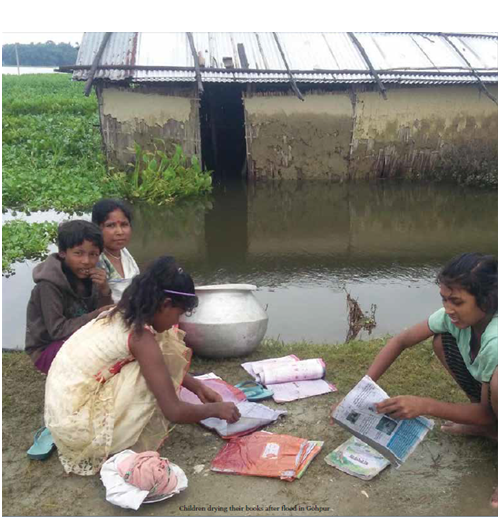Devastating flood and the misery in its wake
For instance, this year’s ravaging deluge that is one of the worst in the State in our living memory, has till writing this piece, has claimed 69 lives while over 57 lakh persons in 4,626 villages under 114 revenue circles of 29 districts are affected. The worst-affected districts include Nalbari, Barpeta, Dhubri, Goalpara, Kamrup, Kamrup (M), Demaji, Lakhimpur, Cachar, Karimgang, Morigaon, Karbi Anglong, Golaghat, Majuli, Dibrugarh and Jorhat.
However, in the recent second wave over two Lakh hectares of cropland have been affected. Many people have been rendered homeless while others have taken shelter in the relief camps, nearby highlands and embankments, educational institutions as also empty spaces between railway lines in some areas of Dhubri. Floods have this time inundated 90% of the world famous Kaziranga national park putting the lives of animals in great peril. As many as 129 animals in the park including 7 rhinos have reportedly lost their lives in the recent wave of floods which has commenced from July continuing for about several days.
The devastating flood reminds of 2017 that had played havoc with the people for about a period of five months, equally devastating as the floods of 2016. But they were not as ravaging as the recent wave of floods, in terms of money and materials.
If the State’s economy based primarily on agriculture is weakened, it is the flood that is largely to blame for its moribund state.
To argue precisely, flood started almost at regular interval, ever since the great earth quake of 1950, when the mighty Brahmaputra in tandem with its tributaries such as Dihing, Dibang, and others, had changed its course in different directions menacingly, eroding sizeable portions of several towns, namely Palasbari, Dibrugarh.
Cause
Large-scale and perennial flood-induced destructions is indeed a matter of serious concern. But why do high floods occur here at regular intervals?
One prime reason behind it is the incessant rainfall in the catchment areas of the upstream of the Brahmaputra basin.
And, the other the rise of the river –bed triggered by the deposition of silts on river-beds, large-scale deforestation, Shoddy and unscientific embankments, filling up of water bodies, ponds, climate change, marshy land - which had for decades together served as flood-cushion-- and, last but not the least, the encroachment of low-lying areas.
No wonder, it is for all these reasons that there was such an unprecedented flood in Kerala in August last year which the State had never witnessed in the past more than 80 years.
In order to assuage the feelings of the flood-affected people, Union Jal Shakti Minister Gajendra Singh Shekhawat, recently announced that the government is finding long-term and permanent solution to tackle flood. To get at the root of the problem, he said a hydro- graphic survey would be undertaken on the rivers of the State. Good news though it is, he has not stated when it will be carried out and when completed.
Thousands of flood hit people still in relief camps: Dhubri
It left a trail of devastation all around in Dhubri district which surpassed the record of 1988’s great flood level 30.36 MTS at Dhubri.
Thousands of flood hit people still in relief camps as low lying areas under knee-deep water in Dhubri town. Nearly, 1.4 lakh people of Dhubri town affected by flood while 397 villages with population of 5,50,368 squarely hit by this unprecedented flood.
Officials informed 32,371 people including 7,575 children had to leave homes and take shelter in 96 relief camps across the district. Over hundreds of school buildings, Anganwadi Centres, government offices, embankments, irrigation canals and bunds, PWD roads, culverts were severely damaged.
Road link with rest of Assam from Dhubri was disrupted as both sides approach of a culvert at Ailengamari on NH 31 was washed away on July 23 due to overtopping stream of water from Gaurang river under Bilasipara Sub-Division of Dhubri district.
Due to unprecedented flood, Dhubri District Jail had to be shifted to Dhubri Girls’ College on July 17, but an under trial prisoner ( UTP) had escaped from designated Jail. However, within 56 hours, the prisoner was rearrested by Dhubri DSP (Head Quarter), Trinayan Bhuyan who led the team and conducted raids in several places of Dhubri , Goalpara and South Salmara-Mancachar districts.
Amid this, 20th anniversary of Kargil War ----Vijay Diwas was celebrated as the Indian Army remember its fallen heroes with humanitarian gesture by distributing relief materials at various places of the district.
To express its solidarity with the victims, create awareness and highlight the plight of the local populace, ‘Run for Assam’ was conducted by the unit of Red Horns Division in Hakama village of Dhubri on July 21. Over 120 service personnel of Indian Army took part in ‘Run for Assam’.
Army distributed relief materials like food packets and disinfectants among the flood hit people. Entire Dhubri district including Dhubri town, headquarter of the district, also reeled under darkness as power supply was cut owing to submerging of transformers for six days from July 15.
However, 13,400 electricity connections (town area) was restored within six days while same was restored in rest of the district in a week.
Dwaipayan Dasgupta
Bijoy Kr Sharma
To read the further articles please get your copy of Eastern Panorama August issue @http://www.magzter.com/IN/Hill-Publications/Eastern-Panorama/News/ or mail to contact @easternpanorama.in



